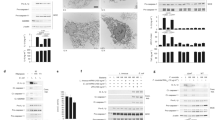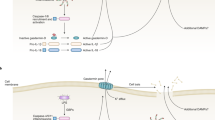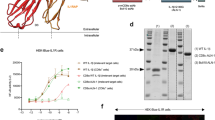Abstract
Aluminium adjuvants, typically referred to as ‘alum’, are the most commonly used adjuvants in human and animal vaccines worldwide, yet the mechanism underlying the stimulation of the immune system by alum remains unknown. Toll-like receptors are critical in sensing infections and are therefore common targets of various adjuvants used in immunological studies. Although alum is known to induce the production of proinflammatory cytokines in vitro, it has been repeatedly demonstrated that alum does not require intact Toll-like receptor signalling to activate the immune system1,2. Here we show that aluminium adjuvants activate an intracellular innate immune response system called the Nalp3 (also known as cryopyrin, CIAS1 or NLRP3) inflammasome. Production of the pro-inflammatory cytokines interleukin-1β and interleukin-18 by macrophages in response to alum in vitro required intact inflammasome signalling. Furthermore, in vivo, mice deficient in Nalp3, ASC (apoptosis-associated speck-like protein containing a caspase recruitment domain) or caspase-1 failed to mount a significant antibody response to an antigen administered with aluminium adjuvants, whereas the response to complete Freund’s adjuvant remained intact. We identify the Nalp3 inflammasome as a crucial element in the adjuvant effect of aluminium adjuvants; in addition, we show that the innate inflammasome pathway can direct a humoral adaptive immune response. This is likely to affect how we design effective, but safe, adjuvants in the future.
This is a preview of subscription content, access via your institution
Access options
Subscribe to this journal
Receive 51 print issues and online access
$199.00 per year
only $3.90 per issue
Buy this article
- Purchase on Springer Link
- Instant access to full article PDF
Prices may be subject to local taxes which are calculated during checkout




Similar content being viewed by others
References
Gavin, A. L. et al. Adjuvant-enhanced antibody responses in the absence of toll-like receptor signaling. Science 314, 1936–1938 (2006)
Piggott, D. A. et al. MyD88-dependent induction of allergic Th2 responses to intranasal antigen. J. Clin. Invest. 115, 459–467 (2005)
Glenny, A. T., Pope, C. G., Waddington, H. & Wallace, U. The antigenic value of toxoid precipitated by potassium alum. J. Pathol. Bacteriol. 29, 31–40 (1926)
Lindblad, E. B. Aluminium compounds for use in vaccines. Immunol. Cell Biol. 82, 497–505 (2004)
Medzhitov, R. Recognition of microorganisms and activation of the immune response. Nature 449, 819–826 (2007)
Mariathasan, S. & Monack, D. M. Inflammasome adaptors and sensors: intracellular regulators of infection and inflammation. Nature Rev. Immunol. 7, 31–40 (2007)
Sutterwala, F. S., Ogura, Y. & Flavell, R. A. The inflammasome in pathogen recognition and inflammation. J. Leukoc. Biol. 82, 259–264 (2007)
Sutterwala, F. S. et al. Critical role for NALP3/CIAS1/Cryopyrin in innate and adaptive immunity through its regulation of caspase-1. Immunity 24, 317–327 (2006)
Martinon, F., Petrilli, V., Mayor, A., Tardivel, A. & Tschopp, J. Gout-associated uric acid crystals activate the NALP3 inflammasome. Nature 440, 237–241 (2006)
Shi, Y., Evans, J. E. & Rock, K. L. Molecular identification of a danger signal that alerts the immune system to dying cells. Nature 425, 516–521 (2003)
Chen, C. J. et al. Identification of a key pathway required for the sterile inflammatory response triggered by dying cells. Nature Med. 13, 851–856 (2007)
Rimaniol, A. C. et al. Aluminum hydroxide adjuvant induces macrophage differentiation towards a specialized antigen-presenting cell type. Vaccine 22, 3127–3135 (2004)
Li, H., Nookala, S. & Re, F. Aluminum hydroxide adjuvants activate caspase-1 and induce IL-1β and IL-18 release. J. Immunol. 178, 5271–5276 (2007)
Mannhalter, J. W., Neychev, H. O., Zlabinger, G. J., Ahmad, R. & Eibl, M. M. Modulation of the human immune response by the non-toxic and non-pyrogenic adjuvant aluminium hydroxide: effect on antigen uptake and antigen presentation. Clin. Exp. Immunol. 61, 143–151 (1985)
Sokolovska, A., Hem, S. L. & HogenEsch, H. Activation of dendritic cells and induction of CD4+ T cell differentiation by aluminum-containing adjuvants. Vaccine 25, 4575–4585 (2007)
Sutterwala, F. S. et al. Immune recognition of Pseudomonas aeruginosa mediated by the IPAF/NLRC4 inflammasome. J. Exp. Med. 204, 3235–3245 (2007)
Mariathasan, S. et al. Differential activation of the inflammasome by caspase-1 adaptors ASC and Ipaf. Nature 430, 213–218 (2004)
Solle, M. et al. Altered cytokine production in mice lacking P2X7 receptors. J. Biol. Chem. 276, 125–132 (2001)
Mariathasan, S. et al. Cryopyrin activates the inflammasome in response to toxins and ATP. Nature 440, 228–232 (2006)
Petrilli, V. et al. Activation of the NALP3 inflammasome is triggered by low intracellular potassium concentration. Cell Death Differ. 14, 1583–1589 (2007)
Pelegrin, P. & Surprenant, A. Pannexin-1 couples to maitotoxin- and nigericin-induced interleukin-1β release through a dye uptake-independent pathway. J. Biol. Chem. 282, 2386–2394 (2007)
Chang, M. et al. Degree of antigen adsorption in the vaccine or interstitial fluid and its effect on the antibody response in rabbits. Vaccine 19, 2884–2889 (2001)
Toda, Y. et al. Autocrine induction of the human pro-IL-1β gene promoter by IL-1β in monocytes. J. Immunol. 168, 1984–1991 (2002)
Jordan, M. B., Mills, D. M., Kappler, J., Marrack, P. & Cambier, J. C. Promotion of B cell immune responses via an alum-induced myeloid cell population. Science 304, 1808–1810 (2004)
Kaye, J. et al. Growth of a cloned helper T cell line induced by a monoclonal antibody specific for the antigen receptor: interleukin 1 is required for the expression of receptors for interleukin 2. J. Immunol. 133, 1339–1345 (1984)
Dunne, A. & O’Neill, L. A. The interleukin-1 receptor/Toll-like receptor superfamily: signal transduction during inflammation and host defense. Sci. STKE 2003, re3 (2003)
Yoshimoto, T. et al. IL-18 induction of IgE: dependence on CD4+ T cells, IL-4 and STAT6. Nature Immunol. 1, 132–137 (2000)
Nakae, S., Asano, M., Horai, R., Sakaguchi, N. & Iwakura, Y. IL-1 enhances T cell-dependent antibody production through induction of CD40 ligand and OX40 on T cells. J. Immunol. 167, 90–97 (2001)
Adachi, O. et al. Targeted disruption of the MyD88 gene results in loss of IL-1- and IL-18-mediated function. Immunity 9, 143–150 (1998)
Davis, C. N. et al. MyD88-dependent and -independent signaling by IL-1 in neurons probed by bifunctional Toll/IL-1 receptor domain/BB-loop mimetics. Proc. Natl Acad. Sci. USA 103, 2953–2958 (2006)
Acknowledgements
We thank L. Zenewicz, Y. Ogura, A. Williams and Y. Wan for discussion and review of this manuscript; A. Coyle, E. Grant and J. Bertin for providing ASC-deficient, Nalp3-deficient and Ipaf-deficient mice; and J. Genzen for providing the P2X7R-deficient mice. This work was supported by the Ellison Foundation, the Bill and Melinda Gates Foundation through the Grand Challenges in Global Health Initiative, and National Institutes of Health grant K08 (F.S.S.). R.A.F. is an Investigator of the Howard Hughes Medical Institute.
Author information
Authors and Affiliations
Corresponding author
Supplementary information
Supplementary Figures
The file contains Supplementary Figures 1-7 with Legends which provide supportive in vitro and in vivo data on the role of Nalp3 in the mechanism of action of aluminum adjuvants. (PDF 157 kb)
Rights and permissions
About this article
Cite this article
Eisenbarth, S., Colegio, O., O’Connor, W. et al. Crucial role for the Nalp3 inflammasome in the immunostimulatory properties of aluminium adjuvants. Nature 453, 1122–1126 (2008). https://doi.org/10.1038/nature06939
Received:
Accepted:
Published:
Issue Date:
DOI: https://doi.org/10.1038/nature06939
This article is cited by
-
Vaccine adjuvants: mechanisms and platforms
Signal Transduction and Targeted Therapy (2023)
-
Dynamics of redox signaling in aging via autophagy, inflammation, and senescence
Biogerontology (2023)
-
USP3 deubiquitinates and stabilizes the adapter protein ASC to regulate inflammasome activation
Cellular & Molecular Immunology (2022)
-
Innate immune detection of lipid oxidation as a threat assessment strategy
Nature Reviews Immunology (2022)
-
Intratumourally injected alum-tethered cytokines elicit potent and safer local and systemic anticancer immunity
Nature Biomedical Engineering (2022)
Comments
By submitting a comment you agree to abide by our Terms and Community Guidelines. If you find something abusive or that does not comply with our terms or guidelines please flag it as inappropriate.



